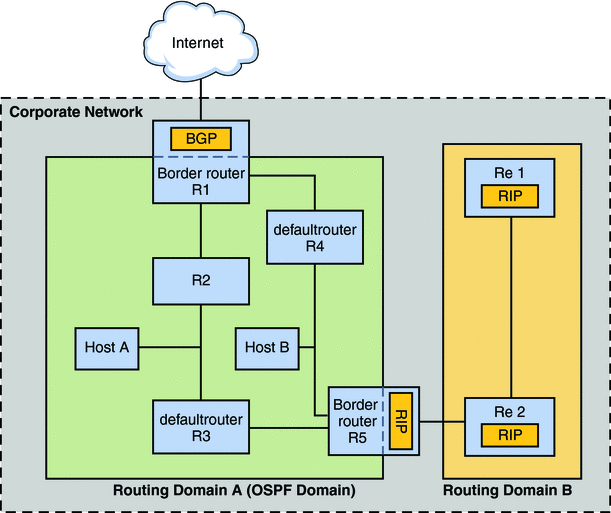Routing Protocols Supported by the Solaris OS
Routing protocols are classified as interior gateway protocols (IGPs), exterior gateway protocols (EGPs), or a combination of both. Interior gateway protocols exchange routing information between routers on networks under common administrative control. In the network topology shown in Figure 5–3, the routers run an IGP for exchanging routing information. Exterior gateway protocols enable the router that connects the local internetwork to an external network to exchange information with another router on the external network. For example, the router that connects a corporate network to an ISP runs an EGP to exchange routing information with its router counterpart at the ISP. Border Gateway Protocol (BGP) is a popular EGP that is used for carrying routing information between different organizations and IGPs.
The following table provides information about the Solaris routing protocols and the location of each protocol's associated documentation.
Table 5–1 Solaris Routing Protocols|
Protocol |
Associated Daemon |
Description |
For Instructions |
|---|---|---|---|
|
Routing Information Protocol (RIP) |
in.routed |
IGP that routes IPv4 packets and maintains a routing table | |
|
Internet Control Message Protocol (ICMP) Router Discovery |
in.routed |
Used by hosts to discover the presence of a router on the network |
How to Enable Static Routing on a Single-Interface Host and How to Enable Dynamic Routing on a Single-Interface Host |
|
Routing Information Protocol, next generation (RIPng) Protocol |
in.ripngd |
IGP that routes IPv6 packets and maintains a routing table | |
|
Neighbor Discovery (ND) Protocol |
in.ndpd |
Advertises the presence of an IPv6 router and discovers the presence of IPv6 hosts on a network |
The Solaris 10 OS also supports the Open Source Quagga routing protocol suite. These protocols are available from the SFW consolidation disk, though they are not part of the main Solaris distribution. The following table lists the Quagga protocols:
Table 5–2 OpenSolaris Quagga Protocols|
Protocol |
Daemon |
Description |
|---|---|---|
|
RIP protocol |
ripd |
IPv4 distance vectoring IGP that routes IPv4 packets and advertises its routing table to neighbors. |
|
RIPng |
ripngd |
IPv6 distance vectoring IGP. Routes IPv6 packets and maintains a routing table. |
|
Open Shortest Path First (OSPF) protocol |
ospfd |
IPv4 link state IGP for packet routing and high availability networking |
|
Border Gateway Protocol (BGP) |
bgpd |
IPv4 and IPv6 EGP for routing across administrative domains. |
The following figure shows an autonomous system that uses the Quagga routing protocols:
Figure 5–2 Corporate Network That Runs Quagga Protocols

The figure shows a corporate network autonomous system that is subdivided into two routing domains, A and B. Arouting domain is an internetwork with a cohesive routing policy, either for administrative purposes or because the domain uses a single routing protocol. Both domains in the figure run routing protocols from the Quagga protocol suite.
Routing Domain A is an OSPF domain, which is administered under a single OSPF domain ID. All systems within this domain run OSPF as their interior gateway protocol. In addition to internal hosts and routers, Domain A includes two border routers.
Border router R1 connects the Corporate Network to an ISP and ultimately the Internet. To facilitate communications between the Corporate Network and the outside world, R1 runs BGP over its externally facing network interface. The border router R5 connects Domain A with Domain B. All systems on Domain B are administered with RIP as their interior gateway protocol. Therefore, border router R5 must run OSPF on the Domain A facing interface and RIP on the Domain B facing interface.
For more information on the Quagga protocols, refer to the Open Solaris Quagga. For configuration procedures for these protocols, go to the documentation for quagga.
- © 2010, Oracle Corporation and/or its affiliates
